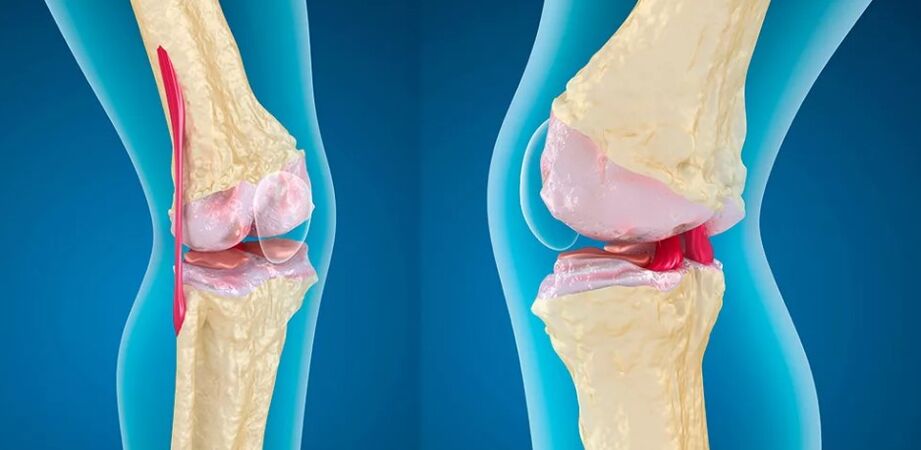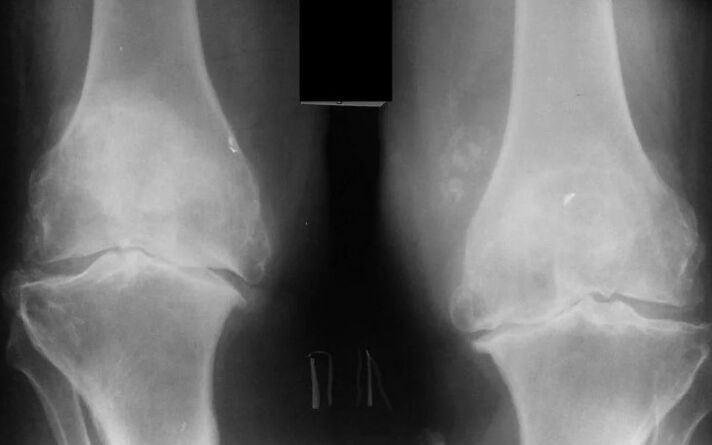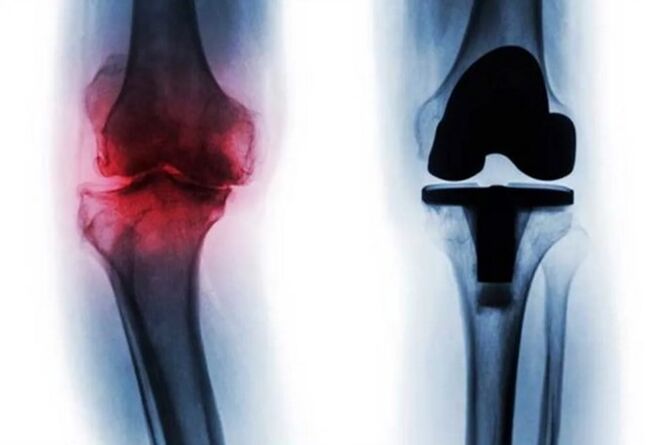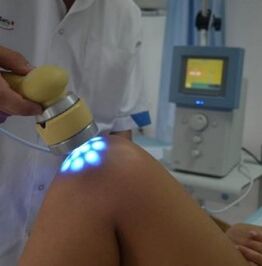Arthrosis is a degenerative -district disease of the joints, characterized by slow and progressive destruction of intraarticular cartilage. Arthrosis includes a group of articular diseases of a devastating-inflammatory nature, which have different causes and similar development mechanisms.
Arthrosis is one of the most common diseases in the world that occupies a major position in women and men over 30 years of age, and with age the risk of developing the disease only increases.

The causes of pathology
Arthrosis develops as a result of a violation of metabolic processes in the joints, against the background of which intraarticular cartilage begins to lose water and becomes non -elastic. Predisposing factors of such changes in the cartilage can be internal and external causes:
hormonal changes;
Age -related characteristics;
genetic predisposition;
rheumatoid arthritis;
Excessive joint load;
Injuries and damage - displacements, fractures, severe bruise, ligament rupture;
Changes in metabolism within the union associated with overweight, diabetes mellitus;
hypothermia;
Inferior and unbalanced nutrition, as a result of which the body does not receive calcium, omega-3 and 6, fats and proteins;
inflammatory process in the union;
violation of the blood supply of the femur's head - refest disease;
Problems with blood coagulation, hereditary diseases;
Autoimmune diseases - red lupus, rheumatoid arthritis.
Specific diseases that have nothing to do with nodes, namely: that is: that is:
syphilis;
hyperthyroidism;
Thyroiditis.
At risk are people who are engaged in heavy physical labor, are forced to hypothermia constantly and experience increased load on the minutes of the muscular system, blacksmiths, athletes, motors, and pregnant women.
Symptoms of arthrosis
The first symptom of arthrosis is the pain in the smallest load on the joints, which quickly passes as soon as the joint is left alone. Arthrosis is characterized by 4 basic clinical signs:

Pain - pain in arthrosis has several features, in contrast to pain in case of random bruise of the joint or inflammatory process in it. First of all, you need to pay attention to the appearance of discomfort and pain with any movement and load on the affected joint. It is worth a person to stop moving and removing the load, as the pain passes immediately, which does not occur when it is injured or inflammation of the joint. At night, the collapse of the collapse practically does not cause discomfort to the patient, painful sensations are only possible when the body's position is changed, but they quickly pass. With a marked progress of destructive processes within the knot, sharp pain can occur at night, which eventually become stronger and make their lifestyle adjustments. Acute pain occurs with any changes in the weather, changing the moon phases, the smallest load.
Crystal - this sound appears as a result of a decrease in the softness of the bone rotation around the joint, which leads to the friction of the bones against one another and is associated with a characteristic crisis. While degenerative processes progress to the joint, the crisis becomes more pronounced and is associated with pain.
Limiting the mobility of the joint - at the initial stage of developing the pathological process of significant mobility restrictions, but while the progress of the joint progresses is increasingly difficult for the patient to perform simple actions. After all, the affected knot becomes completely immobilized.
Common deformation - osteophytes begin to actively grow on the bone surface and accumulate synovial fluid. Deformation of the joint is observed on an advanced degree of the pathological process.
The degenerative processes in the union do not develop rapidly, the disease is characterized by the stages of irritation and forgiveness, from which patients are not rushing to seek medical help, thus contributing to the advancement of destructive processes within the joint.
PHASE
The progress phase of the pathological process in the joint is determined using X -Rry examination. Only 4 stages of the disease are distinguished:
First - characterized by a slight narrowing of the joint gap, while there is no pathological growth in the bones;
Second - there is a slight narrowing of the joint gap, osteophytes form on the bone surface;
The third - the joint gap is narrowed, on the surface of multiple bone osteophytes, the node is observed;
Fourth - there is practically no articular gap, there is numerous osteophytes, a pronounced common deformation.

degree
Arthrosis is expressed in the form of degenerative-destructive processes in the joint, as a result of which the cartilage is being affected, vary in the synovial fusion capsule and the ligaments around it and bone structures. Depending on the severity and severity of these destruction, it is customary to distinguish 3 degrees of arthrosis.
First degree
There is no significant deformation or changes in the joint, but the composition of the synovial fluid is disturbed - this leads to insufficient provision of articular tissue with nutrients, water and microelements, as a result of which the cartilage quickly becomes non -elastic and not adapted to the loads. Over time, this causes inflammatory processes and is associated with pain during movement and load on the joint.
In the first degree of arthrosis, none of their patients require medical help, attributing discomfort and pain an unpleasant position during sleep, fatigue and an incorrect lifestyle. Sometimes the patient may notice a characteristic crisis in the area of the affected joint, but this is not associated with severe pain, but only with discomfort, to which no one pays for considerable attention again.
If arthritis is accidentally diagnosed in the first stage, then the disease is easily treated.
The second degree
At this stage, the disease is associated with devastating processes of cartilage tissue within the joint. Osteophytes grow intensively on the bone surface, and the more intensely the load on the damage area, the more pronounced the destruction will progress.
At the same time, the patient complains of constant pain of a true nature, which passes periodically himself and cannot make himself feel for a long time. Then the disease progresses again. Despite the backdrop of such a pathological process, the muscles that surround the inflamed joint gradually lose their functions, from which the patient quickly tires and cannot resist physical activity, which he endured easily earlier. In the second degree of arthrosis, the patient gradually advances the cartilage and joint deformation.
The third degree
It's the most difficult. The intra -articular jump of the affected joint is thinner and destroyed intensely, which leads to clearly visible deformity and damaged functions of the affected limbs. The ligaments and muscles located near the joint are the lack of nutrients and oxygen and atrophy gradually, which is associated with a marked loss of mobility. At the same time, the patient strives for acute pain all the time, which has been improved by any attempt to change the body's position, with changes in weather conditions and moon stages and gradually leads to a complete loss of legal capacity.

Types of arthrosis
Depending on the cause of the pathological process, primary, secondary and idiopathic arthritis is distinguished within the joint.
The onset develops as an independent, secondary disease, as a result of an injury or infection, and the cause of idiopathic form is not known. In addition to the classification of the disease, depending on the cause of the pathological process, arthritis is distinguished at the site of the localization of destructive changes:
Gonartrosis is the most common type of pathology, characterized by damage to the knee joints. Most often, gonarthrosis is detected in people with excess weight, with chronic metabolic disease in the body, poor immunity. Knee arthrosis progresses for a long time and gradually leads to a complete loss of motor function.
Ankle arthrosis - the main causes of degenerative process development at the ankle joint suffer injuries, displacement, stretch, fractures. In some cases, the development of the pathological process can provoke an autoimmune disease - rheumatoid arthritis. Ankle arthritis is prone to dancers, women who wear high heels, athletes.
Shoulder fusion arthrosis is the main cause of degenerative processes in this area are congenital shoulder union or excess loads in this area, for example, when wearing on the shoulders.
Coxarthrosis or hip joint arthrosis - the main cause of the occurrence is age -related changes in the joint tissue. In danger, people over 45 years old.
Cervical region arthritis - the causes are neck damage, progressive osteochondrosis, overweight, a sedentary lifestyle. At risk, people working on the computer are in the offices. In addition to severe neck pain, patients have pronounced dizziness, inhibition of consciousness, memory damage and fatigue. These symptoms are due to the compression of the vertebral artery through which the nutrients and oxygen enter the brain.
Spondylarthrosis - destructive destruction is subject to spinal column tissue, namely its lumbar department. In a woman's risk group during menopause, as spondillartrosis progresses against the backdrop of a female sex hormone deficiency.
Finger osteoarthrosis - develops for the same reason as spondillartrosis.
Polartrosis - characterized by damage to numerous joints with progressive degenerative processes in them, while ligaments, muscles and tissue fusion are involved in the pathological process.

The treatment of arthrosis
The treatment of arthrosis is best done in the early stages, then the disease is better undergoing conservative methods of therapy. It is very important to accurately put the cause of the progressive destructive changes in the union and stop these factors in time.
The treatment of arthrosis is performed comprehensively and consists of eliminating the inflammatory process, stopping the pain syndrome, stopping the progression of the pathological process and, if possible, the restoration of lost joint functions. Conservative therapy involves the choice of medicines and methods of physiotherapeutic treatment.
Treatment
Arthrosis treatment is different with different places of localization of the pathological process:
Fingers and hands arthritis -Describe anti -inflammatory non -steroidal medicines in the form of ointments of cream, gel. To prevent the progression of the pathological process, the technique of the chondroprotectors is indicated. After stopping an acute inflammatory process, massage and physiotherapeutic methods of therapy are prescribed.
With arthrosis of the shoulder joint -within the joint, the patient is injected with injectively sedative and non -steroidal anti -inflammatory drugs. They can suspiciously prescribe intake medicines that will relax the muscles and slightly reduce the intensity of the pain. After relieving acute inflammation and pain, physiotherapy and massage are indicated.
Knee joint arthrosis -Describe anti -inflammatory non -steroidal drugs in the country in the type of compresses, ointments, gel. The affected joint area shows the physiotherapeutic method of therapy.
Hip joint arthritis - compresses saturated oil or gel from the NSAID group are applied to the lesion area, and sedatives of sedatives injected into the joint.
Knee joint arthritis - ointments and gels with an analgesic effect are applied to the damage area, and after relief of acute pain and inflammation, physiotherapeutic methods of treatment are shown.
Ankle arthrosis - the patient is recommended by strict bed rest with the rest of the affected joint. While the acute inflammatory process is softened, physiotherapeutic procedures, baths, massage are determined.

Physiotherapeutic treatment
Effective physiotherapeutic methods, often used at varying degrees of arthrosis gravity, include:
Treatment with the shock wave effectively eliminates the patient from increasing osteophytes, thus eliminating pain and restrictions of joint mobility;
Muscle stimulation around the affected joint with electricity-this procedure is very effective for patients with limited significant mobility and allows you to improve blood circulation in the joint, accelerate regenerative processes, increase muscle tone;
Ozonotherapy - a gas mixture is inserted into the affected joint cavity, due to which the patient decreases, the motility of the joint is normalized, and signs of inflammation disappear. For maximum effect, ozone therapy is performed in courses;
Phonoforesis - the effect on the field of ultrasound waves using medication. This method of using medication is much more effective, as ultrasonic waves give the medicine directly to the lesion.
Moreover, the treatment of physics-therapy includes exercise therapy, massages, manual therapy, mechanism.
Dietary food
The arthrosis diet should be more balanced and richer with unsaturated fatty acids, proteins, trace elements. It is recommended to include fresh fish, vegetable oils, cottage cheese, dairy products, meat, fresh vegetables and fruit in the diet.
Flour products and "fast" carbohydrates, chocolate, coffee, alcohol, pork, fatty and sharp dishes should be excluded from the diet.

























